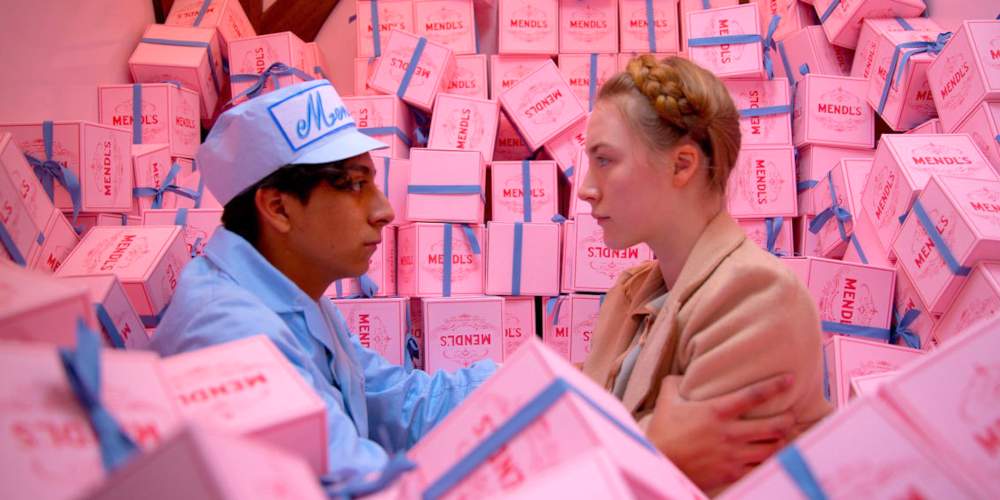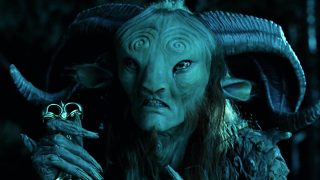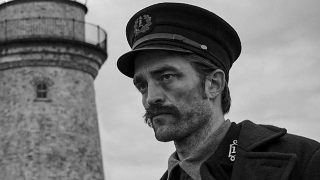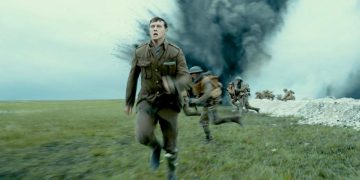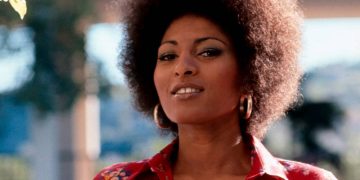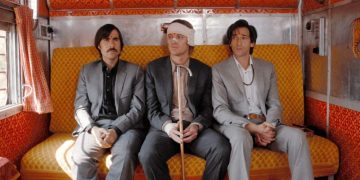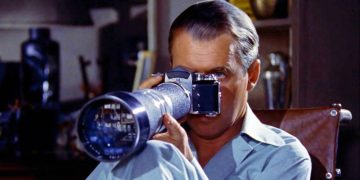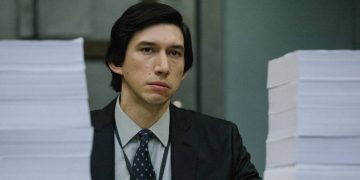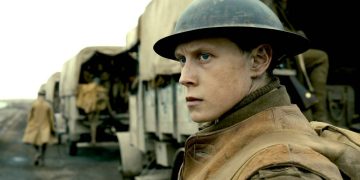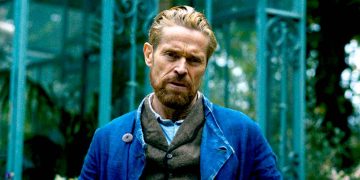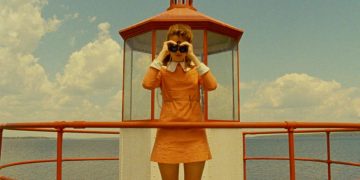There are so many elements that go into making a film that you might not even notice half of them. Filmmakers and cinematographers have to consider everything on screen, from lighting to color grading.
The depth-of-field of each shot also requires careful consideration, as it helps direct the viewer's attention and is one way to guide where their eyes land in any particular shot. Very important in certain scenes.
Depth-of-field refers to the front-to-back range of each frame's focus. In other words, what parts are in focus and what parts are blurred.
In some shots, the whole frame is sharp. In other shots, the background and/or foreground is blurry and only the subject is sharp.
All of this leads to the concept of a deep focus shot, and filmmakers may elect to use this kind of shot to enhance their films.
But what exactly is a deep focus shot? And what does it do for the scene? Read on to find out!
What Is Deep Focus? Explained
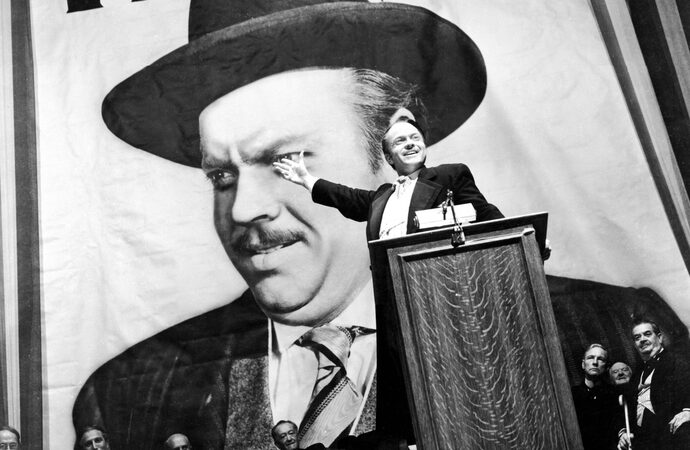
Deep focus sits at one end of the depth-of-field spectrum, and it means that everything in the shot—foreground and background—is sharply focused and visible.
Director Orson Welles was a particular fan of this technique, and he popularized the deep focus technique in his 1941 film buff classic Citizen Kane (which we'll explore some more later in this article).
When a scene is filmed in deep focus, viewers are given the maximum amount of information from the scene. Nothing is hidden. We're forced to take in the background action as much as the foreground, which can imply a link between action, character, and setting.
Or it could just be used to show off the cool set design.
Here are several excellent movies that have used the deep focus shot technique to great effect.
1. Citizen Kane (1941)
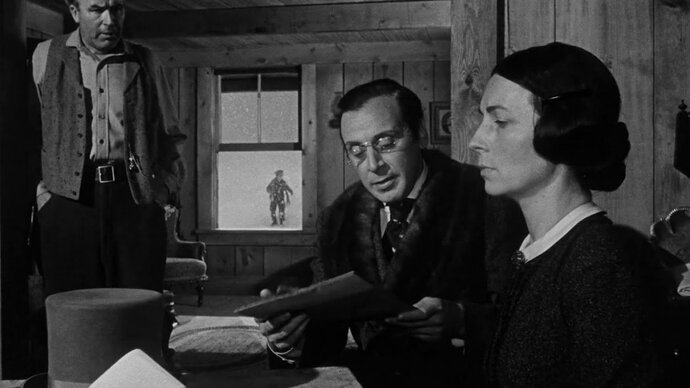
Directed by Orson Welles
Starring Orson Welles, Joseph Cotten, Dorothy Comingore
Drama, Mystery (1h 59m)
Citizen Kane is Orson Welles's most famous film—and by extension, his most famous use of the deep focus shot.
One quick Google search reveals a ton of YouTube essays and scholarly articles about the flashback scene to Charles Foster Kane's childhood. In this scene, young Charles can be seen playing in the snow through the window, way back in the background.
Thanks to cinematographer Gregg Toland's employment of deep focus, we aren't just seeing what's happening inside the room—everything outside of the room is clearly visible, too.
This use of deep focus is particularly clever as it links the core question of the movie and the ending of the film: Who/what is Rosebud?
It wasn't just in Citizen Kane that Welles used deep focus. He used it in pretty much all of his movies.
The next time you watch one, take note of how crisp the details are of everything in the shot. When a character walks toward the back of a set—or leaves the room—see how they remain in constant focus.
It sounds simple and possibly even trivial, but most movies have characters fade into a blur for a more "cinematic" look. By keeping them in sight, your attention isn't drawn away from the character (which may be hinting to an important plot point).
2. Mank (2020)
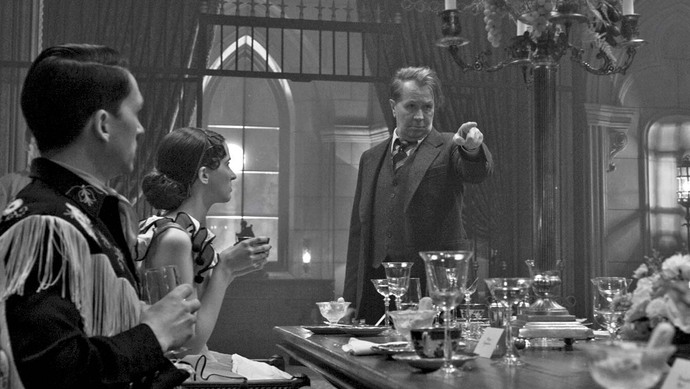
Directed by David Fincher
Starring Gary Oldman, Amanda Seyfried, Lily Collins
Biography, Comedy, Drama (2h 11m)
In ode to Orson Welles, director David Fincher leaned heavily on deep focus in his Oscar-winning historical drama Mank.
Telling the lesser-known story of Herman J. Mankiewicz—the man who actually wrote Citizen Kane—Fincher mimics the style of Welles' famous cinematography.
This doesn't just mean black-and-white film grain. Cinematographer Erik Messerschmidt evoked the aesthetics of Citizen Kane in every way possible, including deep focus.
So when we see Gary Oldman pacing the grand, tall buildings (reminiscent of Citizen Kane's set design), he remains completely visible and in sharp focus, as if it were Welles himself.
3. Atonement (2007)
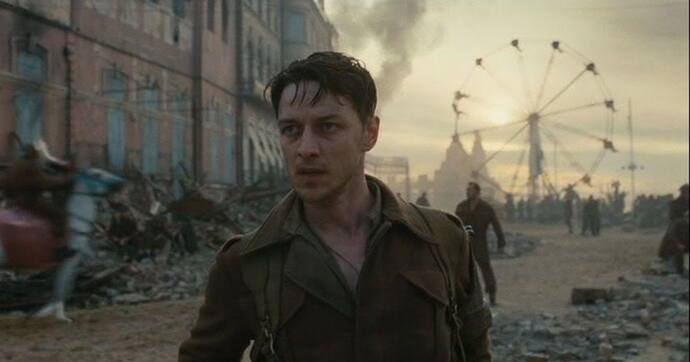
Directed by Joe Wright
Starring Keira Knightley, James McAvoy, Brenda Blethyn
Drama, Mystery, Romance (2h 3m)
We've highlighted the war drama Atonement before for its incredible use of the long take technique, but there's more to the film's greatness than its sheer length of a single take.
Not only is this stately shot done all in one go—without edits—it also makes full use of deep focus.
The whole point of this scene is to show how different men spent their last days on the beaches of Dunkirk. Some play football, some get drunk, some sing together at the bandstand.
It's a touching scene that's full of humanity and emotion, but probably wouldn't have worked if a shallow depth-of-field was used.
Imagine if cinematographer Seamus McGarvey filmed five uninterrupted minutes of carefully choreographed action, just for half of it all to get lost in blurriness and be hard to decipher by viewers.
The scene would've lost all of its impact, and we would've been bored to tears. Deep focus is what makes it so good!
4. Django Unchained (2012)
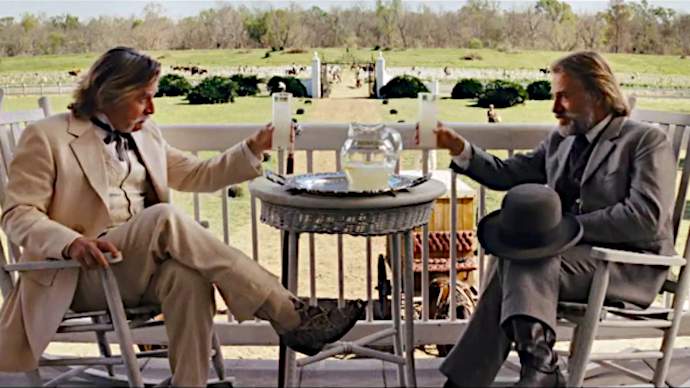
Directed by Quentin Tarantino
Starring Jamie Foxx, Christoph Waltz, Leonardo DiCaprio
Drama, Western (2h 45m)
In Django Unchained, there's one particular setting that Quentin Tarantino kept in full focus throughout the movie: the plantations.
As a key setting in this modern Spaghetti Western, the Candyland plantation is owned by (one of) the antagonists of the film (played by Leonardo DiCaprio).
It's where Django's (played by Jamie Foxx) wife is forced to work, and is eventually blown up in an all-out Tarantino-style ending. Before this is "Big Daddy's" plantation in Tennessee—equally as terrible.
Whenever we're introduced to these grand-yet-horrifying settings, cinematographer Robert Richardson films from the end of the long path leading to the doorway.
The building's whiteness pierces the landscape and asserts its authority over the land and the people working it.
Similarly, whenever a scene takes place on the porch, the background view of the grounds are kept in sight. While the white men casually pour drinks and gaze over their property, the slaves toil on down below.
5. The Darjeeling Limited (2007)
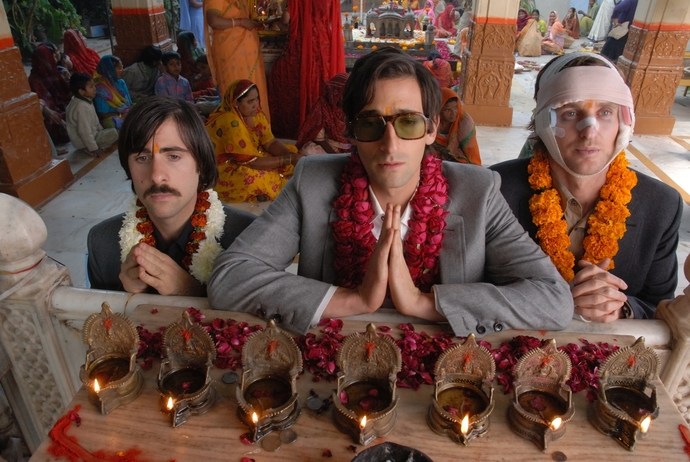
Directed by Wes Anderson
Starring Owen Wilson, Adrien Brody, Jason Schwartzman
Adventure, Comedy, Drama (1h 31m)
Most of Wes Anderson's films are shot in deep focus, but it doesn't get mentioned much because his filmmaking style is dominated by distinct use of symmetry, birds-eye shots, and whip-pans.
However, none of these would work nearly as well if not shot in deep focus by cinematographer Robert Yeoman. Deep focus is the element that allows those other cinematic choices to shine.
We'll look at The Darjeeling Limited for this entry, but the same can be applied to any Anderson movie.
In The Darjeeling Limited, the setting and design play an integral role in the narrative. Therefore, it only makes sense for it to always be in focus.
As a story about three brothers going on a journey across India, the vibrant colors of Indian culture must be acknowledged and celebrated.
The rituals, arts, and practices of Hindu temples and Christian convents guide the brothers' journey of self-discovery, filling the screen with gorgeous architecture, set pieces, and nature.
6. Rear Window (1954)

Directed by Alfred Hitchcock
Starring James Stewart, Grace Kelly, Wendell Corey
Mystery, Thriller (1h 52m)
Legendary director Alfred Hitchcock often used deep focus to create suspense. After all, he's nicknamed the "Master of Suspense"!
In Psycho, the Bates Motel is just as clear as the characters inhabiting it—especially Norman Bates (Anthony Perkins). This technique makes the creepy taxidermy décor one with the villain.
But Psycho has already been dissected to death by film scholars, so let's look at a different Hitchcock example: Rear Window.
A deep depth-of-field is crucial for the narrative of Rear Window. The plot is based around a photographer with a broken leg, who has nothing to do except watch his neighbors across the road. (The voyeuristic theme is common to many of Hitchcock's films.)
Jeff (played by James Stewart) thinks he witnesses a murder through his telescope and tries to solve it. Now, imagine if Robert Burks used a shallow depth-of-field here? We wouldn't be able to see anything happening through the windows!
Before the murder even takes place, Hitchcock gives us a famous peek into the courtyard opposite, zooming in on the windows of Jeff's neighbors during a heatwave. To see so far into the opposing rooms, deep focus is a technical necessity.
7. All the President's Men (1976)
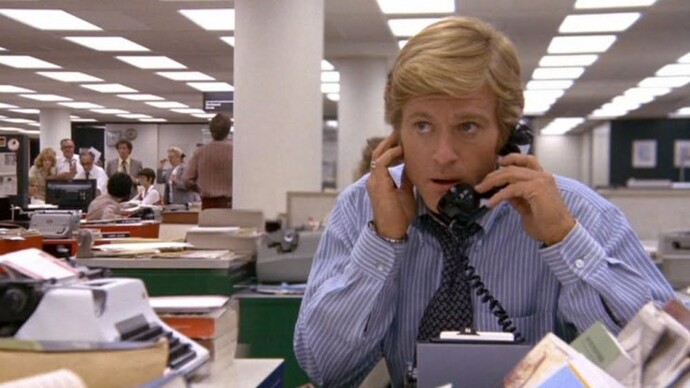
Directed by Alan J. Pakula
Starring Dustin Hoffman, Robert Redford, Jack Warden
Drama, History, Thriller (2h 18m)
This one's a bit of a cheat because, technically, All the President's Men employs a split diopter shot rather than traditional deep focus. In other words, it creates the illusion of deep focus.
This is accomplished by attaching a partial lens to a standard lens, creating two different focal planes that look to be a deep focus shot, except obscure in a way you can't quite put your finger on...
This shot is used in a famous 6-minute-long take where Bob Woodward (played by Robert Redford) makes a phone call while the rest of the news team gathers in the back, left-hand corner.
As cinematographer Gordon Willis slowly zooms on Redford's face, we can't help but be drawn to the hubbub and wonder what's afoot.
Alan J. Pakula's journalistic biopic is based on the true story of two men investigating the Watergate scandal for The Washington Post. As the nature of the movie is all about uncovering secrets, distractions, and lies, the use of deep focus and diopter shots is fitting.
8. The Revenant (2015)
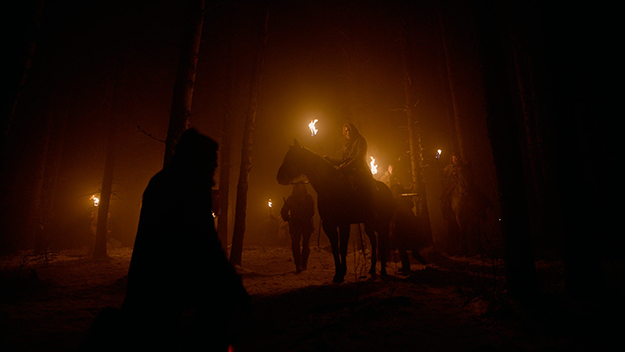
Directed by Alejandro G. Iñárritu
Starring Leonardo DiCaprio, Tom Hardy, Will Poulter
Action, Adventure, Drama (2h 36m)
At its core, The Revenant is a tale of man versus nature, so it's important we actually see the nature that confronts Hugh Glass (played by Leonardo DiCaprio, based on a real fur trapper).
Beyond the famous grizzly bear attack, Hugh has to fight against enemies, hypothermia, drowning, and starvation to survive the frosty American Frontier.
Therefore, cinematographer Emmanuel Lubezki shows all these things clearly in the background, creeping up and looming over Hugh's fate.
But director Alejandro G. Iñárritu doesn't reduce nature to just something to survive against. It's beautiful, panoramic, and somewhat spiritual, representing Hugh's soul connection to his lost family.
Lubezki won an Academy Award for presenting nature in this dualistic way, using wide-angle lenses to capture the terror, awe, and grandeur of the Dakota wilderness.
And what would be the point of it all if Lubezki were to use a shallow depth-of-field that fizzles all the fear and beauty away?
9. Portrait of a Lady on Fire (2019)
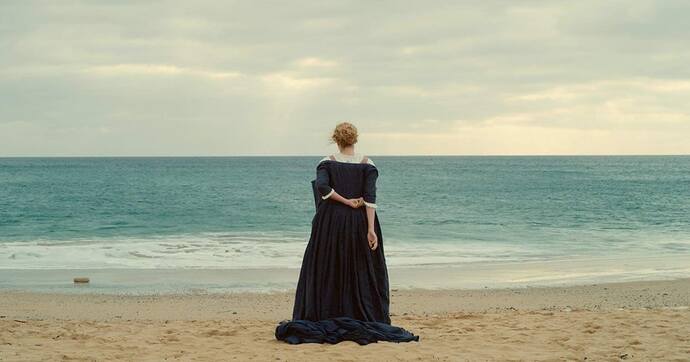
Directed by Céline Sciamma
Starring Noémie Merlant, Adèle Haenel, Luána Bajrami
Drama (2h 2m)
Due to Portrait of a Lady on Fire's narrative, the use of deep focus is a fundamental technical choice. It couldn't be without it.
Céline Sciamma's historical romance is about a woman having her portrait done. In light of this, Claire Mathon makes the cinematography itself look like a painting—crisp lines, precise colors, no blurry edges!
Héloïse (played by Adèle Haenel) and Marianne (played by Noémie Merlant) are forbidden lovers in 18th century France, and shots of them on the beach are particularly prevalent throughout the movie, marrying shades of cyan sea with emerald green dresses and sandy beige.
It's crucial that all of this is sharp, detailed, and ultra high-def to echo Marianne's artistic work, who's commissioned to watch Héloïse in secret and paint her from memory.
The deep focus also helps Portrait of a Lady on Fire to achieve that sophisticated, polished look that keeps with its gentry setting.
10. Gravity (2013)
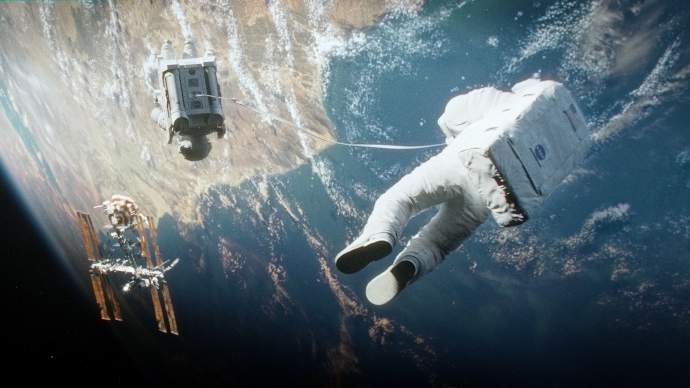
Directed by Alfonso Cuarón
Starring Sandra Bullock, George Clooney, Ed Harris
Drama, Sci-Fi, Thriller (1h 31m)
For any film about space, it's important that you can actually see space—not just the inside of a spaceship. But it's even more important for a film like Gravity, which is truly about the emptiness of space itself.
As the only surviving crew member left on the Explorer space shuttle, Dr. Ryan Stone (played by Sandra Bullock) floats around the atmosphere trying to make communication with Earth.
Lovely as she is, it would be a total bore to watch nothing but Bullock's face for 90 minutes clanking around a metal container. Luckily, we've got the sweeping views of the universe in the background, thanks to director Alfonso Cuarón and cinematographer Emmanuel Lubezki.
One sequence in particular makes marvelous use of deep focus: when Ryan becomes entangled in parachute cords, Matt Kowalski (played by George Clooney) detaches himself from his tether to save her.
As they twirl about in zero gravity, the Earth looms huge behind them, each cloud and continent finely detailed from thousands of miles away.
